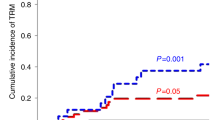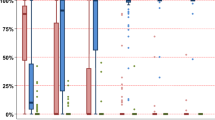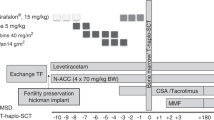Abstract
Little information is currently available on the outcome and the long-term restoration of immune function in infants with combined immunodeficiency and residual T cells (T+ CID) treated by BMT. We prospectively followed patients with T+ CID who received matched unrelated donor BMT at our center. Engraftment, immune reconstitution and transplant-related complications were recorded. Humoral and cellular immunity were evaluated. Ten patients with combined immune deficiency who had more than 1000 circulating T cells/μl were designated as having T+ CID. They were diagnosed at a mean age of 9.7 months and received a matched unrelated donor BMT at the mean age of 17.4 months. All 10 patients are alive and well at a mean of 110 months after transplant. All patients have evidence of full hemopoietic engraftment and robust immune function. We have shown here that matched unrelated donor BMT is highly effective in curing patients with T+ CID. This mode of treatment should be preferred for patients with T+ CID when a related identical donor is not available.
This is a preview of subscription content, access via your institution
Access options
Subscribe to this journal
Receive 12 print issues and online access
$259.00 per year
only $21.58 per issue
Buy this article
- Purchase on Springer Link
- Instant access to full article PDF
Prices may be subject to local taxes which are calculated during checkout
Similar content being viewed by others
References
Buckley RH . Molecular defects in human severe combined immunodeficiency and approaches to immune reconstitution. Annu Rev Immunol 2004; 22: 625–655.
Haddad E, Landais P, Friedrich W, Gerritsen B, Cavazzana-Calvo M, Morgan G et al. Long-term immune reconstitution and outcome after HLA-nonidentical T-cell depleted bone marrow transplantation for severe combined immunodeficiency: a European retrospective study of 116 patients. Blood 1998; 91: 3646–3653.
Antoine C, Muller S, Cant A, Cavazzana-Calvo M, Veys P, Vossen J et al. Long-term survival and transplantation of haemopoietic stem cells for immunodeficiencies: report of the European experience 1968–99. Lancet 2003; 33: 1089–1095.
Caillat-Zucman S, Le Deist F, Haddad E, Gannagé M, Dal Cortivo L, Jabado N et al. Impact of HLA matching on outcome of hematopoietic stem cell transplantation in children with inherited diseases: a single-centre comparative analysis of genoidentical, haploidentical or unrelated donors. Bone Marrow Transplant 2004; 33: 1089–1095.
Ball LM, Lankester AC, Bredius RG, Fibbe WE, van Tol MJ, Egeler RM . Graft dysfunction and delayed immune reconstitution following haploidentical peripheral blood hematopoietic stem cell transplantation. Bone Marrow Transplant 2005; 35 (Suppl 1): S35–S38.
Patel DD, Gooding ME, Parrott RE, Curtis KM, Haynes BF, Buckley RH . Thymic function after hematopoietic stem-cell transplantation for the treatment of severe combined immunodeficiency. N Engl J Med 2000; 342: 1325–1332.
Notarangelo LD, Giliani S, Mazza C, Mella P, Savoldi G, Rodriguez-Pérez C et al. Of genes and phenotypes: the immunological and molecular spectrum of combined immune deficiency: defects of the gamma(c)-JAK3 signaling pathway as a model. Immunol Rev 2000; 178: 39–48.
Arpaia E, Shahar M, Dadi H, Cohen A, Roifman CM . Defective T cell receptor signaling and CD8+ thymic selection in humans lacking Zap-70 kinase. Cell 1994; 76: 947–958.
Sharfe N, Dadi HK, Shahar M, Roifman CM . Human immune disorder arising from mutation of the á chain of the interleukin-2 receptor. Proc Natl Acad Sci USA 1997; 94: 3168–3171.
Alarcon B, Regueiro JR, Arnaiz-Villena A, Terhorst C . Familial defect in the surface of expression of the T-cell receptor CD3 complex. N Engl J Med 1988; 319: 1203–1208.
Sharfe N, Shahar M, Roifman CM . An interleukin-2 receptor γ chain mutation with normal thymus morphology. J Clin Invest 1997; 100: 3036–3043.
Somech R, Roifman CM . Mutation analysis should be performed to rule out γc deficiency in children with functional severe combined immune deficiency despite apparently normal immunologic tests. J Pediatr 2005; 147: 555–557.
Roifman CM . Studies of patients’ thymi aid in the discovery and characterization of immunodeficiency in humans. Immunol Rev 2005; 203: 143–155.
Zhang J, Quintal L, Atkinson A, Williams B, Grunebaum E, Roifman CM . Novel RAG1 mutation in a case of severe combined immunodeficiency. Pediatrics 2005; 116: e445–e449.
Roifman CM, Gu Y, Cohen A . Mutations in the RNA component of RNase MRP cause Omenn Syndrome. J Allergy Clin Immunol 2006; 117: 897–903.
Hirschhorn R . Overview of biochemical abnormalities and molecular genetics of adenosine deaminase deficiency. Pediatr Res 1993; 33 (1 Suppl): S35–S41.
Fischer A, Friedrich W, Fasth A, Blanche S, Le Deist F, Girault D et al. Reduction of graft failure by a monoclonal antibody (anti-LFA-1 CD11a) after HLA nonidentical bone marrow transplantation in children with immunodeficiencies, osteopetrosis and Fanconi's anemia: a European group for immunodeficiency/European Group for Bone Marrow Transplantation report. Blood 1991; 77: 249–256.
Tsuji Y, Imai K, Kajiwara M, Aoki Y, Isoda T, Tomizawa D et al. Hematopoietic stem cell transplantation for 30 patients with primary immunodeficiency diseases: 20 years experience of a single team. Bone Marrow Transplant 2006; 37: 469–477.
Dalal I, Reid B, Doyle J, Freedman M, Calderwood S, Saunders F et al. Matched unrelated bone marrow transplantation for combined immunodeficiency. Bone Marrow Transplant 2000; 25: 613–621.
Glucksberg H, Storb R, Fefer A, Buckner CD, Neiman PE, Clift RA et al. Clinical manifestations of graft-versus-host disease in human recipients of marrow from HL-A-matched sibling donors. Transplantation 1974; 18: 295–304.
Guggenheim R, Somech R, Grunebaum E, Atkinson A, Roifman CM . Bone marrow transplantation for cartilage-hair-hypoplasia. Bone Marrow Transplant 2006; 38: 751–756.
Notarangelo L, Casanova JL, Conley ME, Chapel H, Fischer A, Puck J et al. International union of immunological societies primary immunodeficiency diseases classification committee: primary immunodeficiency diseases. J Allergy Clin Immunol 2006; 117: 883–896.
Filipovich AH, Shapiro RS, Ramsay NK, Kim T, Blazar B, Kersey J et al. Unrelated donor bone marrow transplantation for correction of lethal congenital immunodeficiencies. Blood 1992; 80: 270–276.
Grunebaum E, Mazzolari E, Porta F, Dallera D, Atkinson A, Reid B et al. Bone marrow transplantation for severe combined immune deficiency. JAMA 2006; 295: 508–518.
Buckley RH, Schiff SE, Schiff RI, Markert L, Williams LW, Roberts JL et al. Hematopoietic stem-cell transplantation for the treatment of severe combined immunodeficiency. N Engl J Med 1999; 340: 508–516.
Barker JN, Krepski TP, DeFor TE, Davies SM, Wagner JE, Weisdorf DJ . Searching for unrelated donor hematopoietic stem cells: availability and speed of umbilical cord blood versus bone marrow. Biol Blood Marrow Transplant 2002; 8: 257–260.
Anasetti C, Petersdorf EW, Martin PJ, Woolfrey A, Hansen JA . Trends in transplantation of hematopoieticstem cells from unrelated donors. Curr Opin Hematol 2001; 8: 337–341.
Stroncek D, Bartsch G, Perkins HA, Randall BL, Hansen JA, McCullough J . The national marrow donor program. Transfusion 1993; 33: 567–577.
Tiercy JM, Bujan-Lose M, Chapuis B, Gratwohl A, Gmür J, Seger R et al. Bone marrow transplantation with unrelated donors: what is the probability of identifying an HLA-A/B/CwDRB1/B3/B5/DQB1-matched donor? Bone Marrow Transplant 2000; 26: 437–441.
Candusso M, Faraguna D, Landini P . Artifical nutrition and bone marrow transplantation. Haematologica 2000; 85: 58–61.
Bertrand Y, Landais P, Friedrich W, Gerritsen B, Morgan G, Fasth A et al. Influence of severe combined immunodeficiency phenotype on the outcome of HLA non-identical, T-cell-depleted bone marrow transplantation: a retrospective European survey from the European group for bone marrow transplantation and the European society for immunodeficiency. J Pediatr 1999; 134: 740–748.
Martin P, Bleyzac N, Souillet G, Galambrun C, Bertrand Y, Maire PH et al. Clinical and pharmacological risk factors for acute graft-versus-host disease after paediatric bone marrow transplantation from matched-sibling or unrelated donors. Bone Marrow Transplant 2003; 32: 881–887.
Yang YL, Lu MY, Jou ST, Lin KH, Lin DT . Matched-unrelated-donor bone marrow transplantation for children with leukemia. J Formos Med Assoc 2005; 104: 448–451.
Acknowledgements
This work was supported by The Canadian Centre for Primary Immunodeficiency, The Canadian Immunodeficiency Society and The Jeffrey Modell Foundation. CMR is holder of the Donald and Audrey Campbell Chair in Immunology.
Author information
Authors and Affiliations
Corresponding author
Additional information
Conflict of interest
The authors declare no competing financial interests.
Rights and permissions
About this article
Cite this article
Roifman, C., Somech, R. & Grunebaum, E. Matched unrelated bone marrow transplant for T+ combined immunodeficiency. Bone Marrow Transplant 41, 947–952 (2008). https://doi.org/10.1038/bmt.2008.11
Received:
Revised:
Accepted:
Published:
Issue Date:
DOI: https://doi.org/10.1038/bmt.2008.11
Keywords
This article is cited by
-
T-Cell Compartment in Synovial Fluid of Pediatric Patients with JIA Correlates with Disease Phenotype
Journal of Clinical Immunology (2011)
-
Single-center analysis of long-term outcome after hematopoietic cell transplantation in children with congenital severe T cell immunodeficiency
Immunologic Research (2009)



